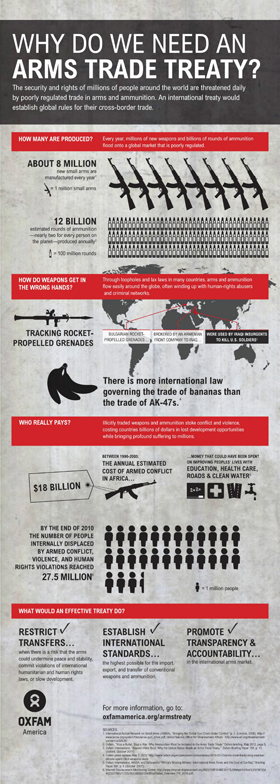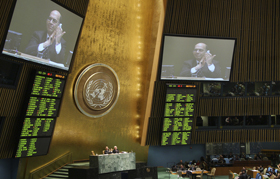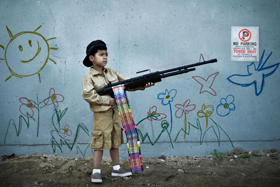The vote on the Arms Trade Treaty at the UN General Assembly on April, 2 came after more than two decades of organizing. The majority of states voted in favor, but it is still a long way before the treaty will have the important specifics figured out. Nevertheless, the adoption of such a treaty is a very important step forward in the universal attempt to curb the sale of weapons that kill tens of thousands of people every year. In this interview Steven Haines, Professor of Public International Law at the University of Greenwich, comments on the adoption of the treaty, its projected effectiveness and shortcomings.
Interview
Almost all international trade in goods is regulated, except for the international arms trade. The misuse of arms to foment genocide or war crimes, support terrorism and organized crime, or diversion of arms into illegal markets are only some of the gravest consequences of such gap in the international law. The vote on the Arms Trade Treaty at the United Nations General Assembly on April, 2 came after more than two decades of organizing. The majority of states voted in favor, but it is still a long way before the treaty will have the important specifics figured out. Nevertheless, the adoption of such a treaty is a very important step forward in the universal attempt to curb the sale of weapons that kill tens of thousands of people every year. In this interview Steven Haines, Professor of Public International Law at the University of Greenwich, comments on the adoption of the treaty, its projected effectiveness and shortcomings.
Interviewee: Steven Haines, Professor of Public International Law at the University of Greenwich
Interviewer: Maria Prosviryakova, Russian International Affairs Council
On April, 2 the United Nations General Assembly voted overwhelmingly to approve the Arms Trade Treaty. What does it mean in the legal context that the treaty that could not be agreed on at the UN Conference and was adopted by the UN General Assembly?
The original intention that the final text would be adopted at the UN Conference on the Arms Trade Treaty by everybody agreeing without a vote was not possible because a number of states in the end said very clearly that they would not be prepared to accept it. The only sensible option, therefore, was to put it to the General Assembly and force a vote on the subject. Only three states – Syria, North Korean and Iran - voted against it. A number of abstained in the vote including, for example, Russia and China, both major weapons manufacturers and exporters. Abstention does not necessarily mean that states are going to continue to remain outside the treaty regime. Russia has said that it will look carefully at the treaty and decide at some other point whether it will be able to support it; we must wait and see what transpires.
Also, the fact that a state voted in favour of the treaty does not necessarily mean it is going subsequently to ratify it. Take the United States, for example. Its government supports the treaty but may find itself in the rather awkward position of not being able to ratify it because the Senate may not deliver ratification in response to the very strong lobby against any sort of gun control in the country.
The treaty will come into force 90 days after the 50th signatory has submitted its ratification. When it comes into force, it will be legally binding. Interestingly, in July’s draft of the treaty the number of states needed to ratify it was higher - 65. Just before the UN GA voting, however, the Australians introduced an amendment in response to a number of states' suggestions that the threshold ought to be lowered to speed up the process by which the treaty comes into force.
Treaties are not perfect and the more parties that are involved in a treaty negotiation, the less perfect it is likely to be, Very obviously, if you are trying to get 193 states onboard, you are going to have to somehow accommodate all of their interests and their positions. This hasn’t been possible so far with the Arms Trade Treaty.
The treaty was adopted by a vote of 154 to 3, with 23 countries abstaining from the vote, including Russia. Russia decided to abstain because the treaty is ambiguous and it doesn’t provide specific implementation and enforcement mechanisms. Of course, the highly complicated negotiations forced compromises that left significant loopholes. What loopholes and weak points are the most obvious and will cause problems in the future?
First of all, we should use this treaty to achieve a raising of international standards that should become progressively watertight as time goes on.
One of the criticisms of this Arms Trade Treaty, as it stands, is that there is no provision in it for enforcement and there are no penalties associated with failure to comply. So, it does immediately raise questions about the extent to which this treaty is going to be effective.
Nevertheless, we have got a document, a process by which it will come into force, a small Secretariat is to be established, review conferences will be held (the first one is planned for 2016) with annual meetings of States Parties thereafter. In the course of time treaties of this nature can develop a life of their own. As the review conferences are held, some of the ambiguities in the treaty text will be ironed out and civil society organizations will again have an important role to play in this process. The majority of the states are very supportive of the treaty and it should lead to a constructive dialogue that will eventually bring us to something more robust than we have now.
If 50 nations ratify the treaty, then it will effectively become the international norm. Given the overwhelming vote, some diplomats anticipated that it could go into effect in two to three years, which is relative quick for an international treaty. How realistic is this estimate and what pitfalls we can face here?
There is a ratification process to be gone through. As an international lawyer, I look at a lot of treaties that have universal ambitions and the trouble with them is that the states that ratify the quickest, in my experience, are the states that are the least likely to be able to enforce it. They ratify it straight away, being very enthusiastic supporters of a convention. But 5 years later, when you ask them what laws they have got in place to enforce that convention, you suddenly discover that they haven’t done anything about it. They formally ratify it at the international level, but domestically their domestic law has not been amended to take account of their new obligations. Strange though it may seem, the longer a state takes to ratify, the more likely it may be to give effect to it through its domestic legal process.
I would hope that in three years we will have all the necessary ratifications for the treaty to come into force. But I am not sure that all states that ratify it in that time would take all the necessary domestic steps to ensure that they themselves will be complying with it.
For the UK it is going to be very easy, because we already comply with the standards laid down in the treaty. But even in the UK, there will need to be parliamentary time allocated to pass its provisions into UK law. All states should go through some form of legislative process to give effect to the treaty before they ratify. Given these considerations, it is difficult to predict how long ratification will take. We will have to wait and see but I think, nevertheless, that the degree of support it was given in the vote clearly gives us grounds to hope for an early entry into force.
What effect will the treaty have on the major arms exporters?
I am not sure about Russia and China, but the treaty is not going to have a massive impact on the major arms suppliers within the European Union (Britain, France, Germany) and the United States, principally because they already comply with the standards that are incorporated in the Arms Trade Treaty. This treaty is trying to raise global standards to a level that already exist.
The goal of the treaty is to curb the arms sales that have fueled many conflicts. This treaty probably won’t solve the problems overnight, no treaty could do that, but will it help to prevent future “Syrias”?
10 years or so ago civil society groups started the process of arguing in favour of the Arms Trade Treaty. They wanted a very effective instrument that would be binding on all states, that would establish a robust Secretariat with plenty of staff working to monitor the arms trade to ensure compliance, and they wanted both an effective enforcement mechanism and influential penalties. The treaty falls well short of those objectives.
To quote Robert Zuber, director of the pro-treaty group Global Action to Prevent War and Armed Conflict: “There is no implementation support, no body that can request reports and subpoena people. We’ve spent 10 years fussing over a piece of paper that has no culture attached to it. Treaties don’t create behavior by themselves.” He is clearly disappointed. That is one end of the spectrum of attitudes to the resultant treaty.
There are others who are reasonably pragmatic and see the way that the treaty has developed over time. They will be more positive about it, because this is a very important starting point. As I have said before, the treaty will develop a life of its own over time and we can hope for progressive development of the regime it establishes.
Having said that, we must not expect too much of this treaty. It aims to regulate the global arms trade not to establish universal peace and security. That would be nice, but it will require much more than a well regulated arms trade. I don’t see it as likely that this treaty will effectively stop all conflicts from breaking out. If a state seeks to import weapons in order to be able to launch an aggressive war the regulations in the treaty may serve to reduce that possibility – indeed, one would hope they would. But the ATT is not a panacea – it will not stop war in general. And unless all states agree to the regulations in the treaty, those that remain outside the regime may well ignore the regulations. But I do stress that the fact that this treaty has been agree is a major positive step in the right direction. We should welcome it and encourage all concerned to comply with its provisions and develop further the arms trade regime it embodies. As for ‘peace in our time’ – well, every little effort helps and we should regard this treaty in that light.
Professor Haines, thank you so much for this interview.







